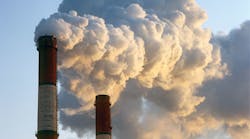Global carbon dioxide emissions from the energy sector held stable for the third straight year in 2016 despite the global economy continuing to expand, the International Energy Agency said Friday.
By far the main culprit in global warming, carbon dioxide emissions stood at 32.1 billion tons last year, the IEA estimated.
This was the same level as the same as the previous two years, despite the global economy growing by 3.1% in 2016.
The IEA said the stabilization of carbon dioxide emissions was the result of growing renewable power generation, switches from coal to natural gas, improvements in energy efficiency, as well as structural changes in the global economy.
"These three years of flat emissions in a growing global economy signal an emerging trend and that is certainly a cause for optimism, even if it is too soon to say that global emissions have definitely peaked," the IEA's executive director Fatih Birol said.
The IEA said carbon dioxide emissions dipped in both the United States and China, the world's two largest energy users and emitters, and were stable in Europe, offsetting increases in most of the rest of the world.
The agency, which advises the world's advanced economies on energy issues, said the United States achieved the largest decline in emissions at three percent, as cheaper shale gas and renewables displaced coal for electricity production.
It said emissions in the U.S. last year were at their lowest level since 1992, a period during which the economy grew by 80%.
Emissions fell by one percent in China last year, the IEA said, while the economy grew by 6.7%. It credited government policies to combat air pollution by switching from coal to natural gas in the industrial and buildings sectors as helping, along with an increasing share of renewables, nuclear and gas in electricity generation.
The IEA said that worldwide half of additional demand for electricity was supplied by renewable sources.
The IEA said that "while the pause in emissions growth is positive news to improve air pollution, it is not enough to put the world on a path to keep global temperatures from rising above" two degrees Celsius (3.6 degrees Fahrenheit).
Holding warming to 2C is the core goal of the 196-nation Paris climate treaty, with increases above that level seen as risking catastrophic climate change.
Copyright Agence France-Presse, 2017



